By Miret Rodriguez
As the curator of the Metro Vancouver art program, Curated Tastes, I often take people to museums, galleries, and artist studios to explore public and private art in the city.
While it’s a curated experience, I give my guests the opportunity to discover things, and be surprised, as if they were exploring the local art scene without a guide.
Spur-of-the-moment encounters with art can offer a span of emotions, whether awestruck, indifferent, or confused. This is the type of unexpected interaction with culture that I try to cultivate in what I do. Below is a handful of the public art that has surprised me and made me think while scouting for my tours. Some works are long gone, others will be soon installed, and others still are being fought for and likely to be relocated.
Hopefully you’ll discover a few new pieces while you’re next walking around!
Burnaby
Old Column (2017)
By Annie Han and Daniel Mihalyo of Lead Pencil Studio
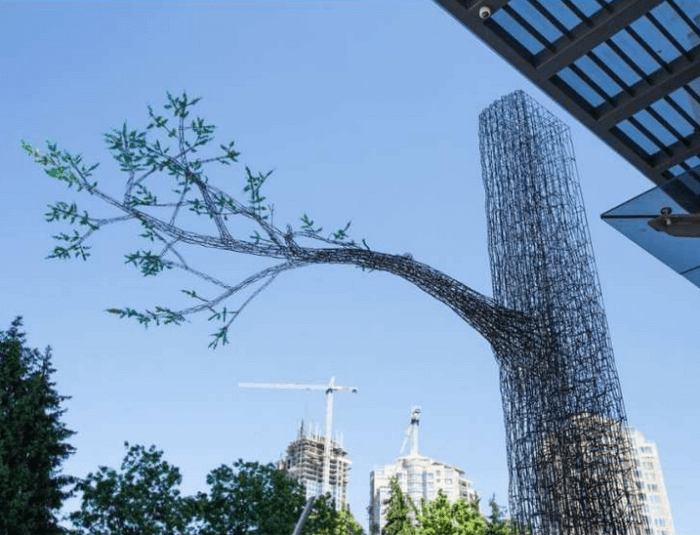
This 25-foot metal sculpture, shaped like a Douglas fir, stands at the corner of Willingdon Avenue and Beresford Street. The blackened stainless steel and steel wire filigree make reference to the Douglas firs you can enjoy nearby at Burnaby’s Central Park. The texture and pattern of the sculpture resemble cellular structures based on images of microscope cross-sections of wood.
When the artists conceived this piece, they sought to show the transition from the natural to the urban environment. As they saw the 37-story tower developed nearby, they were struck by the buildings’ verticality and the area’s density. Concepts that they reference with the texture and shape of the sculpture.
With Old Column, they hope to instill curiosity in the passersby about how the piece was made, encouraging people to touch and interact with it. When you see it in person, look up for the one branch that sticks out one side. You will see bright leaves in different shades of green that sprout and shine. A comment perhaps, on both the fragility and power of nature?
For more info on this piece, visit: boffo.ca/art-seen-old-column-recalls-burnabys-former-old-growth-forest/
Shed (2014) and Blacktail (2015)
By Jacqueline Metz and Nancy Chew of Muse Atelier
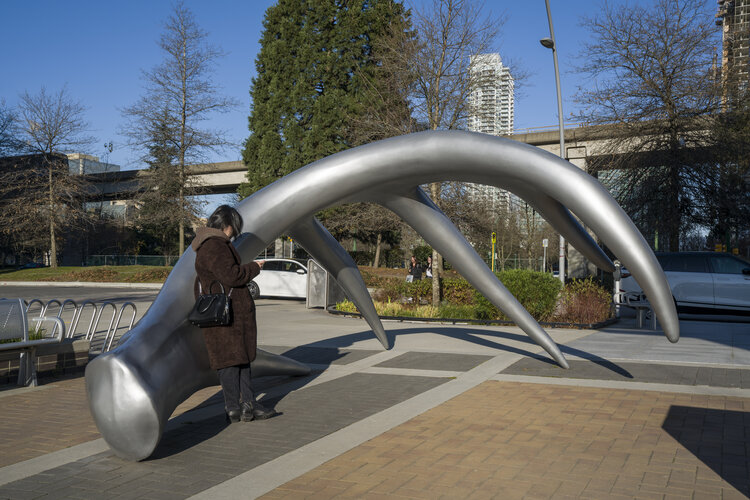
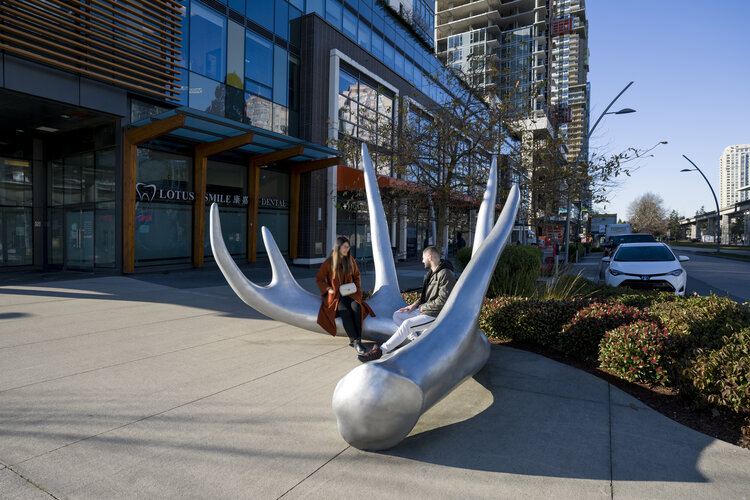
Two things that I always appreciate when I’m out and about all day are places to sit and areas to take shelter from the weather. Shed and Blacktail offer these comforts through art. Both pieces are similar in size, material and shape, but a simple change of orientation makes one deer antler a bench and the other a shed.
I like how each sculpture is placed on parallel streets (Silver and Telford Ave.), making you wonder as a pedestrian if you just had a déjà vu or if you’re walking in circles. The confusion will hopefully have you heading back to explore the pieces further.
With these pieces, the artists hoped to capture deer antlers’ elegant and elemental form and transform them through scale (3x3x3m) and material (aluminum). After encountering both pieces, I can attest to the instinctive attraction to interact with them. They first draw you in through their recognizable shape and capture you with the softness of their lines. It’s interesting how the artists converted a cold, uninviting material like aluminum into a welcoming and cozy place.
For more info about these pieces, visit: metzchew.com/blacktail-shed
Langley
Pillars (2020)
By Brandon Gabriel
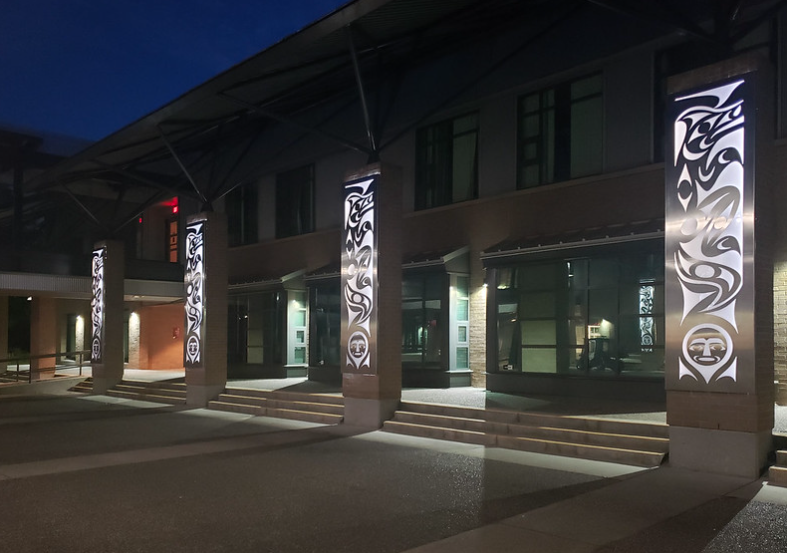
Four pillars telling the Indigenous story of the wolf welcome residents and visitors of Kwantlen Polytechnic University. Brandon Gabriel from the Kwantlen Nation was a high school student when he designed KPU’s Coat of Arms in 1998; he then studied at KPU from 1999 to 2003. For him to design and produce these majestic pillars creates a unique connection between his community and his personal story.
The story of the wolf is an important symbol to the Kwantlen people, as its symbol is also the Nation’s crest. When each steel and acrylic panel illuminates the courtyard at night, it’s hard not to visualize the story and how the wolf became a beacon of teaching, learning, hunting and community.
For more info about this piece, visit: kpu.ca/news/2020/05/20/new-indigenous-artwork-kpu-langley
New Westminster
Sentinel (2016)
By Jacqueline Metz and Nancy Chew of Muse Atelier
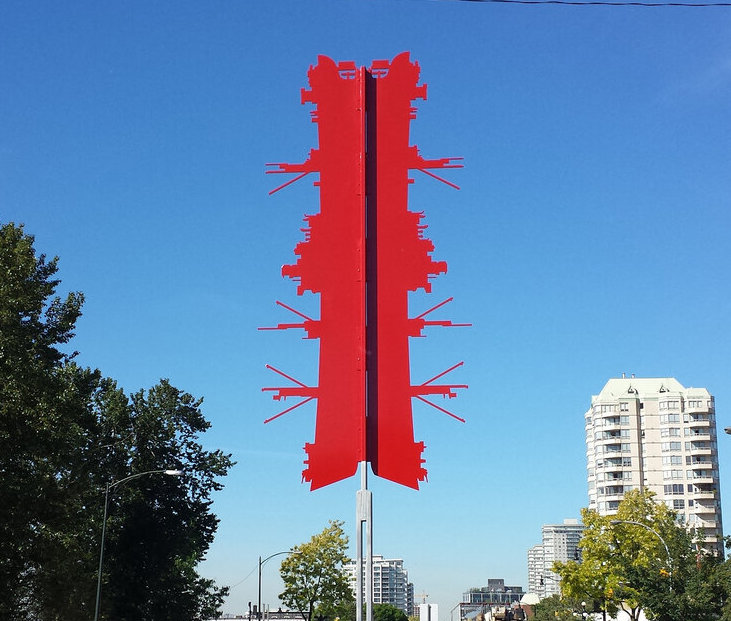
A piece that I’ve really come to appreciate in New Westminster is Sentinel by Jacqueline Metz and Nancy Chew (remember the artists behind the Burnaby deer antlers?). Although I wasn’t particularly taken by this piece when I first saw it (I furrowed my brow trying to make sense of it), that actually seems to be the intention behind it. To stop and challenge you with its mystery and have you consider what you are seeing.
Take a moment and look at the image of this work again. Do you see anything familiar?
This red powder-coated aluminum silhouette is one of a found image of a WW2 Victory ship. While the subject references local history, its design of a monochromatic mirrored image references a Rorschach (inkblot) test. This association is an engaging reminder that there are countless interpretations of a piece like this, ultimately revealing more about ourselves than the work itself.
For more info about this piece, visit: newwestcity.ca/public-art/rorschachsentinel.php
Miyiwts, (2023)
By James Harry
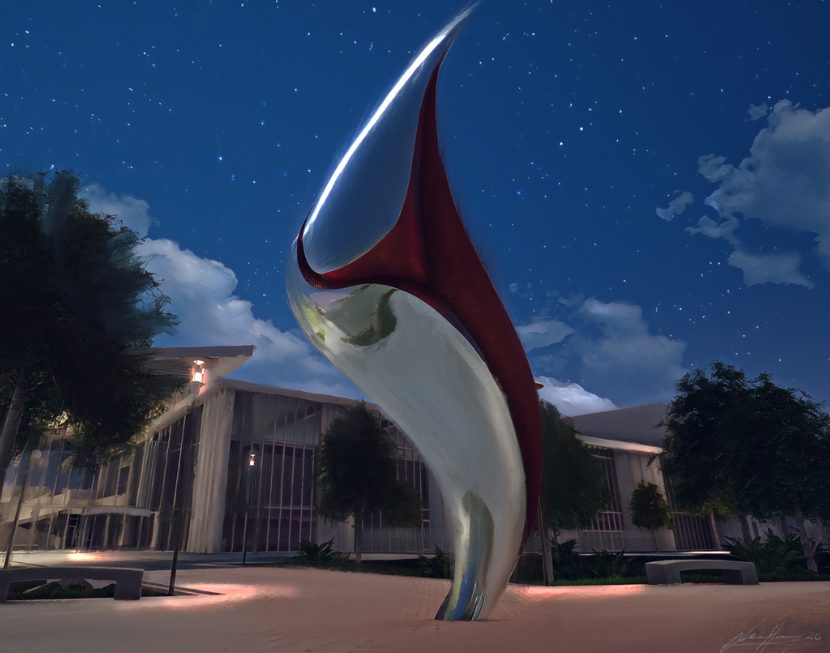
A piece that has yet to be installed at the time of this writing, I am particularly excited and highly anticipating James Harry’s work for the New Westminster Aquatic Centre. Miyiwts will be a large-scale (approx. 16′ tall) sculpture referencing traditional Coast Salish design motifs and the Glenbrook Ravine site. The material finish will be mirror polished stainless steel with gold gilding, installed above corten steel inlay.
For more info on this piece, visit: Jamesharry.ca/projects/2020/6/25/miyiwts
North Vancouver
Spirit Trail Mosquito Creek Marina Murals (2002)
By Siobhan Joseph and Ray Natraoro
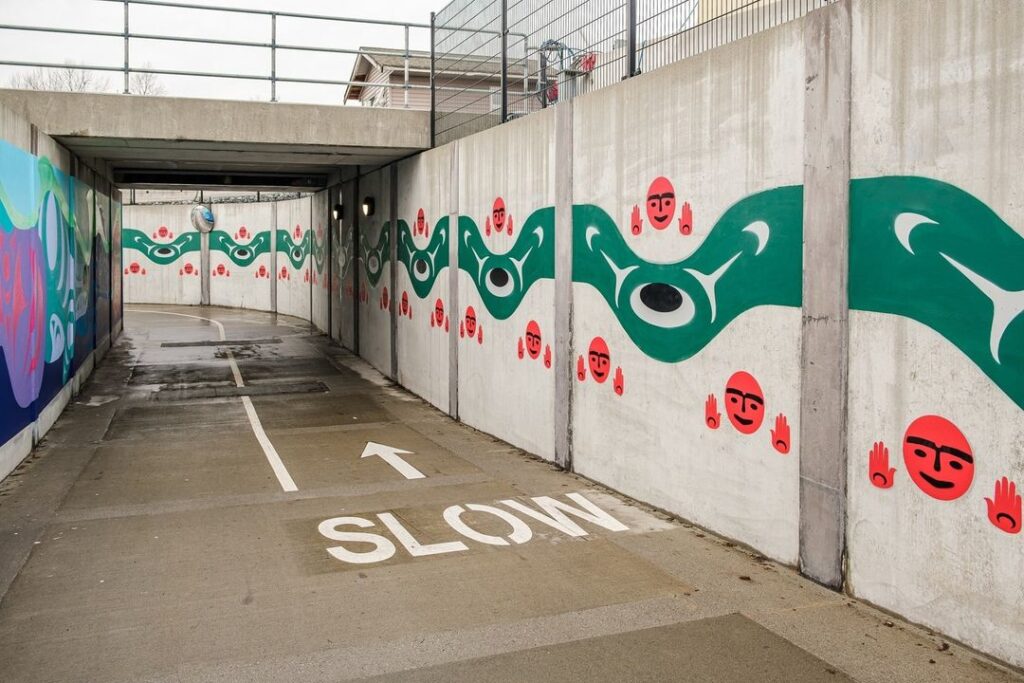
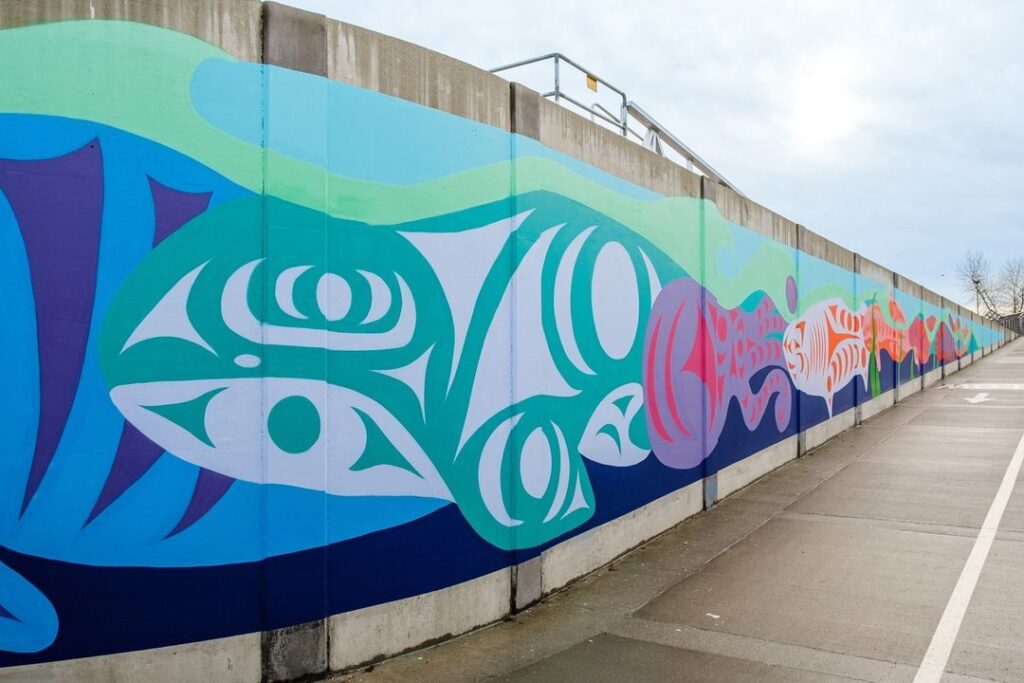
While walking with a friend this past fall along the Mosquito Creek Marina in North Vancouver, we saw long murals in progress on both sides of the underpass.
On the south wall, depictions of rich sea life in saturated warm and cool colours transformed the previous lifeless squared concrete walls into a vivacious and undulating aquatic garden. Whales, octopi, sea otters and salmon all animate the path. Siobhan Joseph’s mural honours the sea life of the Pacific Ocean and its importance to the Squamish Nation people. The gray whale mirroring on each side of the red and black salmon design refers to the Squamish legend of how the salmon first came to the Squamish Rivers.
On the north wall, the repeated motifs of human faces in Squamish form illustrate Ray Natraoro’s ancestors in the Chilh Temixw (heavens). They accompany a serpentine body depicting Coast Salish design elements like the trigon, ovoid and crescent. Natraoro’s mural honours the Squamish Nation Members, Indigenous ancestors, and the Village of Esla7a.
Hacer Memoria
By Rebecca Belmore
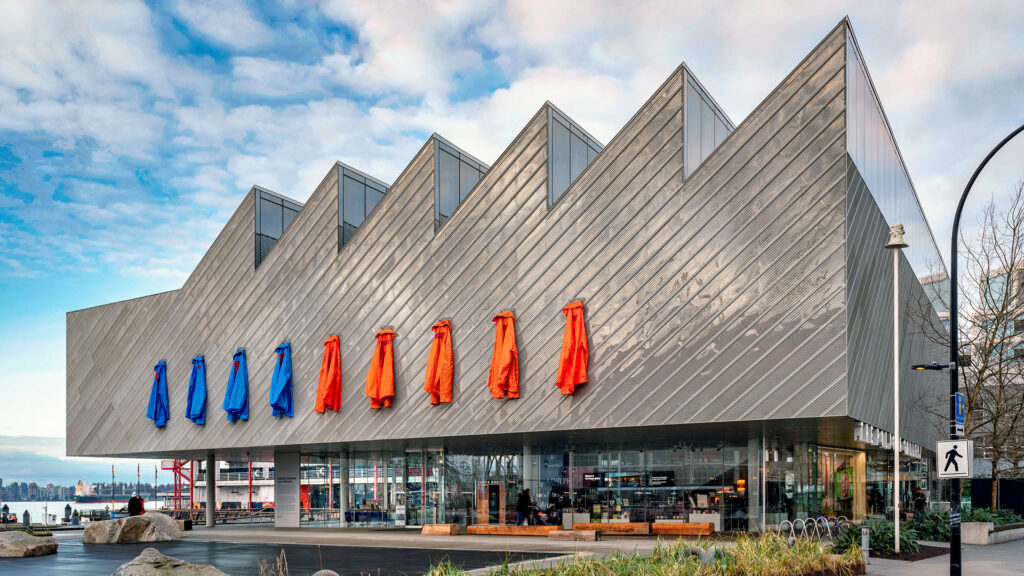
A temporary piece worth checking out and reflecting upon hangs on the facade of the iconic Polygon Gallery right now.
It’s an outdoor installation along the gallery’s east-facing façade. Nine oversized blue and orange shirts sewn from tarpaulins hang in a row with the backs facing out. Each is emblazoned with a single letter, and together they spell “hereafter.”
The way the long-sleeved shirts interact with the environment reminds me of the architect’s intention for the facade’s mirrored stainless steel finish to reflect and mimic the colours of the Burrard Inlet. These shirts however, hang loosely under the mercy of the wind, rain and sun.
Artist Rebecca Belmore used industrial-grade tarpaulin to comment upon its everyday use in developments on unceded Indigenous land, provisional shelters, and Burrard Inlet wharves.
Hacer Memoria is accompanied by Severance, a second installation inside the gallery’s stairwell. Severance is made of black plastic mesh tarpaulin, recalling strands of black hair as a reminder of the shorn hair of Indigenous children in Indian Residential Schools.
For more info, visit: thepolygon.ca/exhibition/rebecca-belmore-hacer-memoria

To easily plan the route for your next artistic outing, you can use the TransLink Trip Planner.
The post 9 Pieces of Local Public Art You Might Not Know About appeared first on West Coast Curated.
